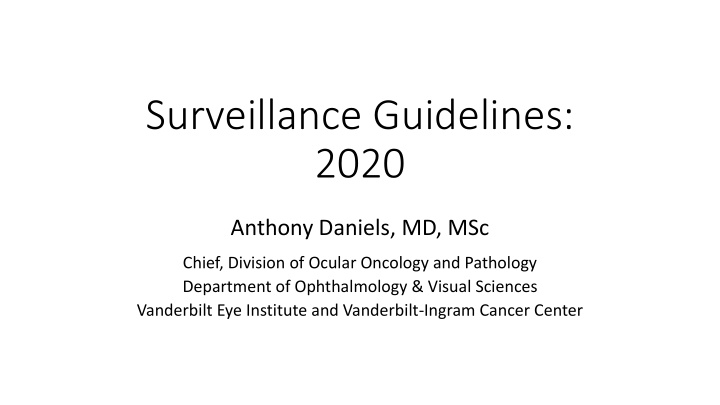



Surveillance Guidelines: 2020 Anthony Daniels, MD, MSc Chief, Division of Ocular Oncology and Pathology Department of Ophthalmology & Visual Sciences Vanderbilt Eye Institute and Vanderbilt-Ingram Cancer Center
I have n e no rel elevant d disclosures es or fin financia ial c l conflic flicts t to report
Background
Background
Background • Bienniel International VHL Medical/Research Symposium • Panel discussion
Background • Bienniel International VHL Medical/Research Symposium • Panel discussion • Need for evidence-based guidelines • Need for large panels of experts in each specialty • Need for more detailed recommendations
• Broad search of English and foreign language literature • Literature related to each specific question was evaluated by different committee members • All literature and guidelines discussed at committee • Evidence graded according to Shekelle criteria
Evidence to Recommendations From Shekelle, et al., 1999
• National Comprehensive Cancer Network (NCCN) • Standardized system for reporting strength of guideline • Based on degree of consensus among the panel • Category 2A: • “Uniform consensus of the panel that the intervention is appropriate”
Guidelines by Organ System • CNS • Eye • Endocrine • Pancreas • Auditory/Endolymphatic Sac • Renal
CNS • MR Imaging • Entire craniospinal axis • Every 2 years • Beginning at age 11 • Stop after age 65 • Prior to a planned pregnancy
Eye • DILATED ophthalmic examination • Begin within first year of life • Every 6-12 months until age 30 • At least yearly after age 30 • Continue screening throughout life (no age to stop) • Consider EUA in children if office exam insufficient • Screen prior to planned pregnancy, and every 6-12 months during pregnancy • EvUltrawidefield photography and fluorescein angiography may be as adjuncts to, but cannot replace, a detailed dilated funduscopic examination • en small extramacular / extrapapillary RHs should be treated promptly
Eye • DILATED ophthalmic examination • Begin within first year of life • Every 6-12 months until age 30 • At least yearly after age 30 • Continue screening throughout life (no age to stop) • Consider EUA in children if office exam insufficient • Screen prior to planned pregnancy, and every 6-12 months during pregnancy • Ultrawidefield photography and fluorescein angiography may be as adjuncts to, but cannot replace, a detailed dilated funduscopic examination • Even small extramacular / extrapapillary RHs should be treated promptly
Renal • MRI abdomen, with and without gadolinium • Beginning at age 15 • Every 2 years • If no tumor detected • Detailed algorithm for small RCCs • Refer larger/growing RCCs • Prior to planned pregnancy • If needed during pregnancy, avoid gadolinium • After age 65, stop routine asymptomatic surveillance • For patients who have never developed RCCs
Pancreas • MRI with gadolinium, with arterial phase • Begin at age 15 • Every 2 years if no lesions found • PNET <15 mm, stable on two consecutive scans: Followed every 2 years • PNET >15mm, or interval growth: Refer • After age 65, stop routine asymptomatic surveillance • For patients who have never developed pancreatic NETs • Prior to planned pregnancy
Endocrine • Yearly H&P for signs/symptoms of pheo • Blood pressure and pulse yearly from age 2 • Plasma free metanephrines yearly from age 5 • Abdominal imaging not the primary mode to assess • Abdominal MRI to coordinate with imaging of other abdominal organs (primarily kidneys, but also pancreas)
ELST • Primary: Yearly H&P to screen for audiovestibular signs/symptoms • Diagnostic audiograms • Beginning at age 11 • Every 2 years • After age 65, stop routine asymptomatic surveillance • For patients who have never developed pancreatic NETs • Single baseline high-resolution (1mm slice) MRI of IAC between age 15-20
Putting It All Together
Putting It All Together
Putting It All Together
Putting It All Together
Putting It All Together
Putting It All Together
Putting It All Together
Putting It All Together
Putting It All Together
• MRI of the neuroaxis may be obtained at the same time as MRI abdomen, and may be performed under a single long anesthesia event, especially in children. However, both the neuroaxis protocol and the abdominal protocols should be obtained consecutively. It is not recommended to evaluate the abdominal organs solely using a neuroaxis protocol. • Based on contraindications (metallic implants, renal failure, etc.), the following order of imaging priority applies: MRI (w/w/o) > MRI (w/o) > CT (w/) > CT (w/o) > US.
Thank Y You!
Thank Y You!
Recommend
More recommend